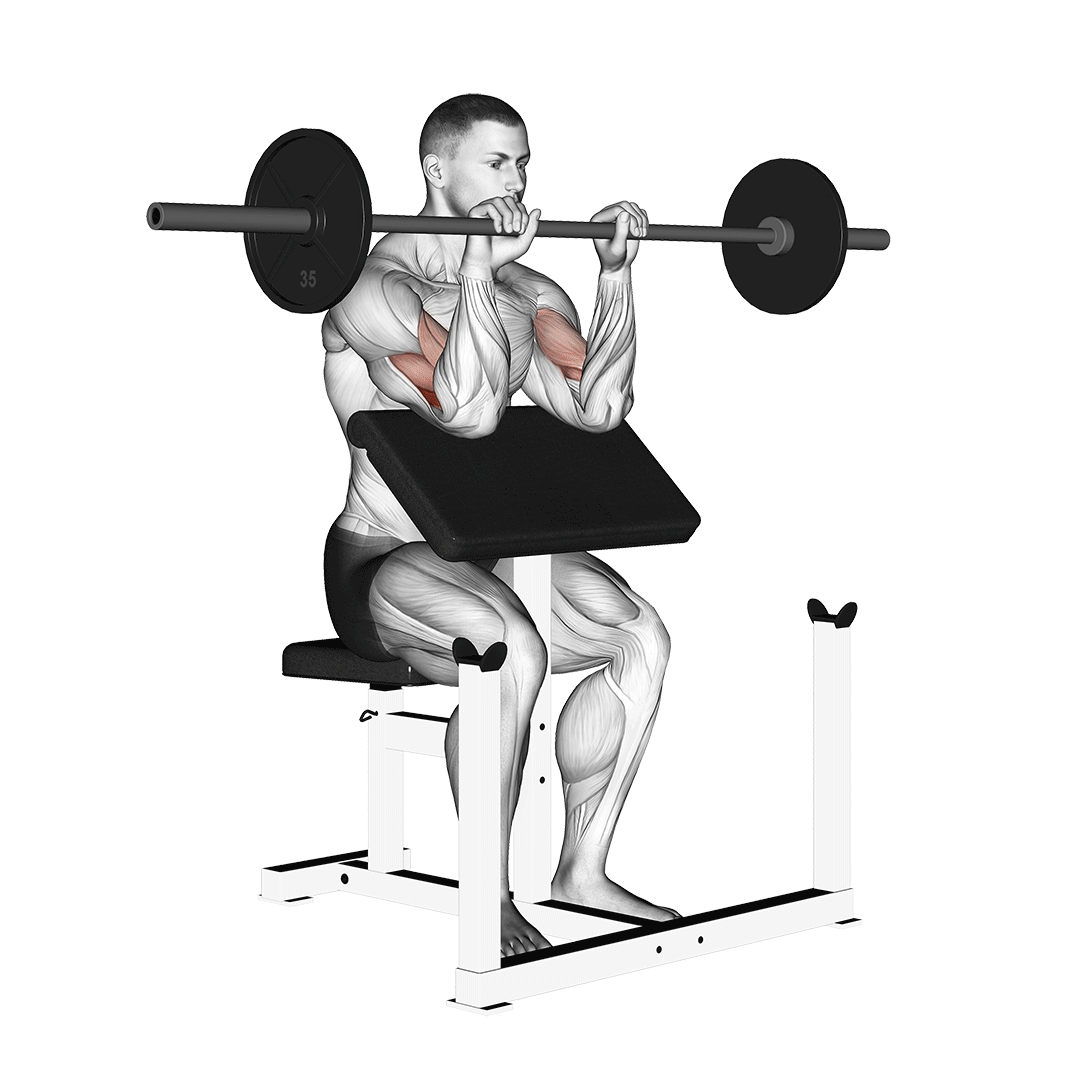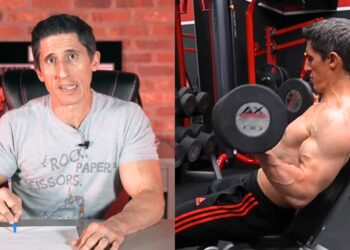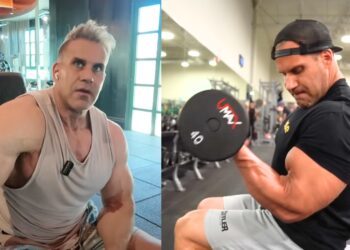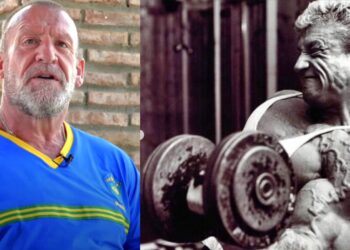The Barbell Reverse Preacher Curl is an effective exercise for building stronger, more defined biceps. Utilizing a reverse grip, it targets not only the biceps brachii but also the brachialis and brachioradialis, essential muscles for enhancing the overall size and strength of your arms. Suitable for all fitness levels, this exercise can seamlessly fit into your routine, whether you’re just starting out or aiming to maintain muscle tone in your later years.
To maximize the effectiveness of the Barbell Reverse Preacher Curl, aim to perform it 2-3 times a week, allowing for recovery between sessions. A typical workout includes 3 sets of 8 to 12 repetitions, focusing on maintaining proper form. Common mistakes to avoid include using excessive weight and letting your upper arms lift off the preacher pad, which can lead to injuries. Prioritize form by keeping your elbows stationary throughout the curl.
All you need is a barbell and a preacher curl bench, readily available at most gyms. If needed, start with lighter weights or dumbbells to build strength gradually. Embrace this challenge, and you will soon see noticeable improvements in your arm strength and aesthetics.
How to Do a Barbell Reverse Preacher Curl

Starting Position:
- Sit at a preacher curl bench with your feet flat on the floor.
- Place a barbell on the rack in front of you.
- Grip the barbell with an overhand grip (palms facing down), hands shoulder-width apart.
- Position your upper arms firmly against the preacher pad, ensuring your armpits are snug against the top of the pad.
Execution Steps:
- Begin with Arms Extended: Start with your arms fully extended downward, holding the barbell just above the pad.
- Engage Your Biceps and Forearms: Inhale, and while keeping your upper arms stationary, slowly curl the barbell upward by contracting your biceps and forearm muscles.
- Lift to Peak Contraction: Continue curling until your forearms are vertical and the barbell is at shoulder height.
- Pause and Squeeze: Hold the top position for a moment, squeezing your muscles to maximize contraction.
- Lower the Barbell: Exhale as you slowly lower the barbell back to the starting position in a controlled manner.
- Repeat: Perform the desired number of repetitions, maintaining proper form throughout.
Breathing Tips:
Level Up Your Fitness: Join our 💪 strong community in Fitness Volt Newsletter. Get daily inspiration, expert-backed workouts, nutrition tips, the latest in strength sports, and the support you need to reach your goals. Subscribe for free!
- Inhale as you lower the barbell.
- Exhale as you lift the barbell.
Common Mistakes
Avoid these common errors to ensure safety and maximize effectiveness:
Level Up Your Fitness: Join our 💪 strong community in Fitness Volt Newsletter. Get daily inspiration, expert-backed workouts, nutrition tips, the latest in strength sports, and the support you need to reach your goals. Subscribe for free!
- Using Too Much Weight:
- Issue: Lifting excessive weight compromises form and increases injury risk.
- Solution: Start with a manageable weight that allows you to perform the exercise with control and proper technique.
- Lifting Upper Arms Off the Pad:
- Issue: Allowing your upper arms to move reduces isolation of the target muscles.
- Solution: Keep your upper arms pressed against the pad throughout the movement.
- Swinging the Barbell:
- Issue: Using momentum diminishes muscle engagement and can strain joints.
- Solution: Perform the exercise slowly and deliberately, focusing on muscle contraction.
- Incorrect Wrist Position:
- Issue: Bending wrists excessively can cause strain.
- Solution: Keep wrists neutral and aligned with your forearms.
- Inconsistent Breathing:
- Issue: Holding your breath can increase blood pressure and reduce performance.
- Solution: Maintain a steady breathing rhythm, inhaling during the lowering phase and exhaling during the lifting phase.
- Incomplete Range of Motion:
- Issue: Not fully extending or curling limits muscle activation.
- Solution: Allow arms to fully extend at the bottom and curl all the way up to maximize the range of motion.
Benefits of the Barbell Reverse Preacher Curl
Incorporating the Barbell Reverse Preacher Curl into your workout routine offers several advantages:
- Enhanced Bicep Development: Targets the biceps brachii, brachialis, and brachioradialis for increased muscle size and strength.
- Improved Grip Strength: The overhand grip strengthens the forearm muscles, enhancing grip strength beneficial for other lifts and daily activities.
- Isolation of Arm Muscles: The preacher bench minimizes body movement, allowing for focused muscle engagement and reducing the use of momentum.
- Balanced Muscle Development: Promotes symmetry by engaging muscles often neglected in traditional bicep exercises.
- Reduced Risk of Injury: Controlled movements and supported positioning decrease strain on the wrists and elbows compared to other curling exercises.
- Functional Strength: Strengthens muscles used in everyday tasks, improving overall arm functionality.
Exercise Variations
Alternative Exercises
Safety Precautions for Barbell Reverse Preacher Curl
When performing the Barbell Reverse Preacher Curl, it is essential to maintain proper form to minimize the risk of injury. Start with lighter weights to master the movement, ensuring that your wrist and elbow joints are supported during each repetition. Improper loading of the barbell can lead to strain in these areas, so gradually increase the weight as your strength improves.
Before you begin your workout, effectively warm up your arms, shoulders, and wrists. Dynamic stretches, such as arm circles and wrist rotations, can prepare these muscle groups for the exercise. Additionally, ensure the preacher curl bench is adjusted properly for your height to prevent any undue stress on your back and shoulders while curling.
Finally, always focus on controlled movements throughout the exercise. Avoid using momentum to lift the barbell, as this can decrease the effectiveness of the curl and increase the risk of injury. If you feel any sharp pain or discomfort, stop the exercise immediately and reassess your technique or the amount of weight you are using.
Conclusion
The Barbell Reverse Preacher Curl is a valuable addition to any strength training routine, offering targeted development of the biceps and forearms while enhancing grip strength. By focusing on proper technique and avoiding common mistakes, you can maximize the benefits of this exercise and achieve noticeable improvements in arm strength and aesthetics.
Remember to start with appropriate weights, maintain consistent form, and incorporate this exercise into your routine 2-3 times per week for optimal results. Embrace the challenge, and you’ll be well on your way to building stronger, more defined biceps.
Interested in measuring your progress? Check out our strength standards for Preacher Curl.








